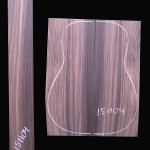
Brazilian rosewood, as every guitarist knows, WAS (note past tense…read on) the traditional premier tonewood for a classical guitar back and sides. It can be one of nature’s most beautiful materials (although species-marginal variants can be pretty drab). It’s density and stiffness seem to be ideal for producing the unique resonance commonly associated with the tone of a classical guitar.
Having said this, Brazilian rosewood was never without its problems. Only a few trees grow straight; others twist and turn while growing, producing wood that can get pretty heavily figured, even gnarled. This can produce stresses and fissures that are sometimes difficult to spot in an unfabricated set. A variety of bugs and worms love the stuff and bore around in the living trees to get their share. All this added up to more work (and often more grief) for the luthier and a higher risk of cracks and warping for the guitarist.
Add to this CITES (Convention on International Trade in Endangered Species). Ah, CITES, intended to keep Dalbergia nigra (that’s the botanical name for Brazilian rosewood) from extinction, but probably destined to assure that very fate. (Who besides governments wants to protect living things that are economically worthless because they are illegal to harvest.) It’s still legal to use wood harvested before June 11, 1992, and a guitar with Brazilian rosewood parts can still be exported if the shipment is accompanied by documentation testifying to it’s provenance (nearly impossible to obtain), but no living Brazilian rosewood trees may be harvested, none. What has happened to the price of Brazilian rosewood? You guessed it: it’s soared.
A few suppliers tried going back to the remnants of old forests in Brazil and harvesting Brazilian rosewood stumps, some of which had been in the ground for decades. Stumps, you say! Actually, what they were after was the taproot. It was all legal under CITES because no living trees were being murdered. The wood was still wet when it was harvested, but the moisture was intra-cellular and dried out quickly. Some of these sets were very excellent in their aesthetic and technical luthiery merits. There’s just one problem: the cost of recovering this wood in a quality level suitable for guitars is extremely high. For this reason, suppliers have all but deserted this market.
If only we could say Brazilian rosewood makes guitars sound better. Many guitarists, including some highly respected ones, are absolutely convinced it does, but, folks, I’m just as convinced it isn’t so, and unlike most guitarists I’ve actually made an attempt in the past to test this with some rigor (see Tone Variables in Guitar Construction).
In spite of all this (because of it?…!), a few guitarists still insist on guitars made of Brazilian rosewood. Sorry, I’m just not willing to struggle with the Brazilian dearth any more, and I don’t have a stash. So you diehard folks really need to get real and take a serious look at the alternatives.
Alternatives to Brazilian Rosewood
Indian rosewood, Brazilian’s top competitor for many years, has none of the drawbacks of Brazilian: it is straight-grained and visually attractive, bughole-free, very stable and, if fabricated under proper humidity conditions, virtually immune to cracking. Indian rosewood is on average about 10% lower in density (which I regard as a significant tone variable) than Brazilian and some other rosewoods, but by careful selection I can come up with Indian sets which are well into the Brazilian density range.
Among other alternatives to Brazilian rosewood that I have used are Madagascar rosewood, Amazon rosewood and Macassar ebony.
In appearance and physical characteristics Madagascar rosewood is as close to a clone for Brazilian as could be found: the grain structure and porosity characteristics are virtually identical; the typical color is like Brazilian rosewood of the brick-red color way. The density range of Madagascar rosewood is virtually identical to Brazilian–between .8 and 1.0 specific gravity. Madagascar rosewood is less prone to the kind of tree-twist figure which sometimes creates instability and tendency to cracking in Brazilian. There are almost no worm- and bugholes. Madagascar rosewood trees tend to be somewhat small, but in spite of this two-piece backs with substantial quartering (2/3to 3/4 of the back) WAS available for classical guitars. That’s right, there’s that pesky past tense again. The one and only supplier I have relied on for years for this wood has announced that he’s getting out of the market. Increasing scarcity, changes in CITES regulations and problems with suppliers appear to be the reasons.
Two additional alternatives on the guitar backs/sides market are Amazon rosewood and Macassar ebony. The supply of these woods is not as dependable as the supply of Indian rosewood, so a luthier either has to have a stash⎼cost-prohibitive to acquire as far as I’m concerned⎼or keep a close eye on the market. Both of these woods are somewhat denser than Brazilian (Madagascar), sometimes over 1.0 specific gravity, but I am tentatively inclined to believe that this may actually help to produce a somewhat warmer sound if the back is graduated properly.
In every respect, Macassar ebony and Amazon rosewood are attractive and acoustically desirable alternatives for Indian and worthy replacements for Brazilian.
